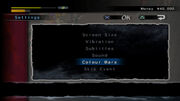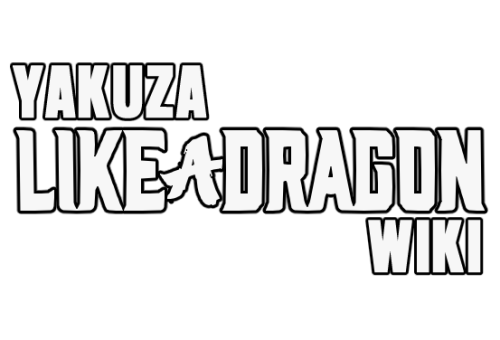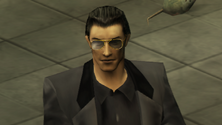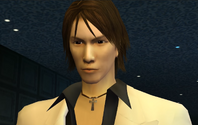Eddiehimself (talk | contribs) No edit summary |
Eddiehimself (talk | contribs) No edit summary |
||
| Line 29: | Line 29: | ||
}} |
}} |
||
{{Quote|Blood. Honour. Respect. Live the Yakuza Legend.|''Yakuza'' tagline}} |
{{Quote|Blood. Honour. Respect. Live the Yakuza Legend.|''Yakuza'' tagline}} |
||
| − | '''''Yakuza''''', originally released in Japan as '''''Like a Dragon''''' ({{JP|龍が如く}} ''Ryū ga Gotoku'') is an action-adventure beat 'em up video game developed and published by |
+ | '''''Yakuza''''', originally released in Japan as '''''Like a Dragon''''' ({{JP|龍が如く}} ''Ryū ga Gotoku'') is an action-adventure beat 'em up video game created by [[Wikipedia:Toshihiro Nagoshi|Toshihiro Nagoshi]], and developed and published by [[Wikipedia:SEGA|SEGA]]. The original PlayStation 2 game was developed between 2002 and 2005<ref name=ignprojectj></ref> and released on December 8, 2005 in Japan, with a worldwide release in September 2006. Additionally, HD remasters have been released in Japan for the PlayStation 3 and Nintendo Wii U in 2012 and 2013 respectively.<br> |
| + | |||
| + | A remake of the game for the PlayStation 4 was released in Japan in 2016, called ''[[Yakuza Kiwami]]''. This remake was released worldwide in August 2017, and on Steam a year later, becoming the second title in the ''[[Yakuza (series)|Yakuza]]'' series officially released on PC. |
||
__TOC__ |
__TOC__ |
||
== Plot == |
== Plot == |
||
| Line 54: | Line 56: | ||
== Development and Release == |
== Development and Release == |
||
| − | On August 6, 2005, SEGA announced that it would be holding a press conference for a new game by [[Wikipedia:Toshihiro Nagoshi|Toshihiro Nagoshi]], titled simply "Project J," on the 23rd of that month.<ref>https://uk.ign.com/articles/2005/08/06/segas-project-j</ref> At the press conference, held in a club in [[Wikipedia:Kabukicho|Kabukicho]], [[Kamurocho]]'s real-life equivalent, SEGA revealed that the new game would be called ''Ryu ga Gotoku'' (like a dragon). At the time, the game had been in development for three years, and was a departure for Nagoshi, who had previously worked on family-friendly games.<ref>https://uk.ign.com/articles/2005/08/23/segas-project-j-revealed</ref> |
+ | On August 6, 2005, SEGA announced that it would be holding a press conference for a new game by [[Wikipedia:Toshihiro Nagoshi|Toshihiro Nagoshi]], titled simply "Project J," on the 23rd of that month.<ref>https://uk.ign.com/articles/2005/08/06/segas-project-j</ref> At the press conference, held in a club in [[Wikipedia:Kabukicho|Kabukicho]], [[Kamurocho]]'s real-life equivalent, SEGA revealed that the new game would be called ''Ryu ga Gotoku'' (like a dragon). At the time, the game had been in development for three years, and was a departure for Nagoshi, who had previously worked on family-friendly games.<ref name=ignprojectj>https://uk.ign.com/articles/2005/08/23/segas-project-j-revealed</ref> |
=== Demo === |
=== Demo === |
||
Revision as of 15:06, 15 August 2019
Template:Game
— Yakuza taglineBlood. Honour. Respect. Live the Yakuza Legend.
Yakuza, originally released in Japan as Like a Dragon (龍が如く Ryū ga Gotoku) is an action-adventure beat 'em up video game created by Toshihiro Nagoshi, and developed and published by SEGA. The original PlayStation 2 game was developed between 2002 and 2005[1] and released on December 8, 2005 in Japan, with a worldwide release in September 2006. Additionally, HD remasters have been released in Japan for the PlayStation 3 and Nintendo Wii U in 2012 and 2013 respectively.
A remake of the game for the PlayStation 4 was released in Japan in 2016, called Yakuza Kiwami. This remake was released worldwide in August 2017, and on Steam a year later, becoming the second title in the Yakuza series officially released on PC.
Plot
October 1, 1995: on a stormy autumn night in the Tokyo entertainment district of Kamurocho, a moustached yakuza family boss lies dead on the floor of his darkened office. The lightning punctuates his features, most notably his broken glasses, through which the bullet that killed him went before entering his head. In front of him stands a grey-suited young man, murder weapon in hand. A posse of police officers swarm into the office, weapons drawn, and order the man to drop the gun. The black-haired young man complies, turning around to reveal his face.
The dead man's name is Sohei Dojima. The grey-suited man, Kazuma Kiryu, is not the one who pulled the trigger on his own patriarch. Rather, the deed was done by his sworn brother Akira "Nishiki" Nishikiyama in order to protect their childhood friend Yumi Sawamura from Dojima's advances. Knowing that Nishiki's sister is gravely ill and needs to be looked after, Kiryu takes the fall for him and serves 10 years in prison for a crime that is not his own.
Ten years later: Kiryu is released from prison into the middle of a crisis within Japan's biggest yakuza organization, the Tojo Clan. Ten billion yen has gone missing from the organization, igniting a power struggle. On top of that, Yumi has gone missing, and Nishiki, now a powerful patriarch of his own yakuza family, is out to kill him. Now, Kiryu must unravel the threads holding these mysteries together with the help of Haruka, a young girl caught in the eye of the storm.
Gameplay
Battle techniques
Offense
- Rush Combo: This determined by the character's use of throwing freestyle fists. It is not a strong impact to be reckoned with but it gives an opportunity for a counterattack towards the enemy, such as dishing out the "Uppercut" as a finishing blow.
Defense
- Guard: To protect your character in unarmed combat, 'Guard' is deployed by drawing your hands back quickly. However, it is insignificant with rear or weapon confrontations. As such, situations need to be assessed.
- Sway: An all-directions quick break away(left,right,forward,backward) that defends the character, when applied well could work favorably.
Heat Action
This option becomes available in the midst of a battle when certain conditions are met and when your character becomes stronger physically and has learned various techniques. This will be expanded below.
Take the upgrade system. You can enhance your character in three areas, including body, technique and soul, each of which affects your abilities as a bruiser. It's possible to create a unique fighter, too, though experience points earned through street fights is rarely scarce. You can often afford to upgrade every aspect of your character often, but the opportunity is there for players who crave technique over health, etc. As you upgrade, you earn new moves and counters. By game's end, you should be throwing lethal uppercuts at the end of your combos and devastating enemies with chairs, poles, boxes, bikes, signs and all sorts of items.
Development and Release
On August 6, 2005, SEGA announced that it would be holding a press conference for a new game by Toshihiro Nagoshi, titled simply "Project J," on the 23rd of that month.[2] At the press conference, held in a club in Kabukicho, Kamurocho's real-life equivalent, SEGA revealed that the new game would be called Ryu ga Gotoku (like a dragon). At the time, the game had been in development for three years, and was a departure for Nagoshi, who had previously worked on family-friendly games.[1]
Demo
Released a few months before its proper retail distribution in December 2005, this test version of the (original Japanese) game starts with a couple of warnings that it is intended for mature audiences only, after which the player will talk with a man in a suit, known as the "Guide", if they want to sample the game proper.
The Guide will give you an overview of the demo's purpose, then present you with a set of options:
- Sample part of the main story, which entails Kiryu returning to Kamurocho to look for Stardust to meet with its owner, so that he can meet with Kazama in secret (10 Years Later). On the way, the player can engage in a few sidequests, fight, and follow the plot until after the run-in with Shimano minions. Once the next cutscene ends, the player is taken back to the "talk" with the Guide.
- The battle tutorial within the Peace Finance base
- Several real battles against random enemies, (seemingly) ending with the Futoshi Shimano boss
- Romance a girl at the hostess club
- Look around the Batting Center, play baseball
- Look around the Casino in Purgatory, gamble
- Return to the title screen
A localized version of this demo was made, accessible only through obtaining a demo compilation disk distributed by Official U.S. PlayStation magazine, also released a few months before the final localization. While mostly identical to the original demo (even using the Japanese audio), this demo starts out with its own trailer, the Shimano boss fight in the Battle Section was cut, and all the swearing, outside of "bastard", is censored. Like the other demos on the disc, but unlike the original demo, the player is only given 30 minutes to try out the Yakuza demo, after which they will be booted back to the disk's main menu.
The translation is also somewhat different in places, with the phrasing of certain things and names being changed in the actual product. For (a more minor) example, Reina is referred to as "Rina".
Regional differences
- Unlike all the other games in the series, the US and European versions of Yakuza came with a full English-speaking voice cast, including Star Wars actor Mark Hamill as Goro Majima.
- Some character names were changed. Shintaro Kazama for example became Shintaro Fuma, and Hanaya the Florist became Kage.
- In the Japanese version, Kiryu would be referred to as such, followed by an honorific (-san, -chan, etc.), very seldom being referred to as "Kazuma". The English version is about the same, only "Kiryu" is replaced with "Kazuma".
- Instances of Kiryu calling Majima, "Big Brother Majima (Majima no nii-san)" was changed to simply "Majima-san" in the dub.
- The Japanese version had chapter names displayed in read-right-to-left calligraphy. In the English version, the chapter names are displayed as normal. The latter would be the case for all Japanese versions moving forward, including Kiwami.
- An English rendering of the abstract font used to display character names in the Japanese version was made for the International release.
- The English dialog is noticeably more vulgar than the original Japanese script, with instances of characters swearing where there wasn't anything of the sort originally.

Example of UK English on the PAL version of Yakuza.
- The PAL version features French, German, Spanish, and Italian text languages, as well as having UK localized English subtitles and menu text. The pre-rendered main screen text however remains in American English. So for example, whilst the screen may display "Get to the lobby!", the subtitles say "Get to the foyer!" and the fight title card against "Street Hoodlums" is subtitled as "Street Hooligans."
Gallery
Screenshots
Notes
Template:Games Navigation Bar
The following page is a list of Missions for Yakuza. There are 79 Missions for this game. Although the term "Mission" is used, it refers to the many substories present in the game.
Certain missions are chapter exclusive, and therefore are missable. Those missions will be marked with a *.
| # | Name |
|---|---|
| 1 | The Price of a D-Cup |
| 2 | My Lover's a Showgirl* |
| 3 | A Doctor's Duty* |
| 4 | The Yakuza's Wife* |
| 5 | Casino Royale* |
| 6 | The Boxing Gamble* |
| 7 | The Truth About the Fake Mizuki* |
| 8 | The Man Who Wanted to Die* |
| 9 | Drunk Guy |
| 10 | Suspicious Man |
| 11 | Suspected Molester |
| 12 | Street Fighter |
| 13 | At Good Cafe |
| 14 | The Price for a Palm-Reading |
| 15 | Handbag Hunt |
| 16 | Chase the Pickpocket |
| 17 | Stalker |
| 18 | Yakuza Hater |
| 19 | Collection Call |
| 20 | Eat and Run |
| 21 | The Accusation |
| 22 | The Bouncer |
| 23 | Art and Talent |
| 24 | Art and Talent 2 |
| 25 | Art and Talent 3 |
| 26 | Art and Talent 4 |
| 27 | Art and Talent 5 |
| 28 | The Graffiti Writer |
| 29 | Chase the Pick Pocket 2 |
| 30 | Ex-Baseball Player |
| 31 | Gang Busters |
| 32 | Gang Busters 2 |
| 33 | Gang Busters 3 |
| 34 | Gang Busters 4 |
| 35 | Gang Busters 5 |
| 36 | The Leader of Gang Busters |
| 37 | Asano the Mastermind |
| 38 | The Truth about Her |
| 39 | The Purse Snatcher |
| 40 | B-King Disaster |
| 41 | Horse Racing Freak |
| 42 | Dying Man's Request |
| 43 | Dying Man's Wish |
| 44 | Dying Man's Hope |
| 45 | Yakuza Candidate |
| 46 | Yakuza Candidate Part 2 |
| 47 | Yakuza Candidate Part 3 |
| 48 | Yakuza Candidate Part 4 |
| 49 | Runaway Yakuza |
| 50 | UFO Catcher |
| 51 | Suspicious Cop |
| 52 | The Little Match Girl |
| 53 | Golden Lighter |
| 54 | Found Cell Phone |
| 55 | My Contact Lenses |
| 56 | No.1 Host |
| 57 | The Scout |
| 58 | Smile Burger Catastrophe |
| 59 | Gelato Shop Cataclysm |
| 60 | Substitute Debt Collector |
| 61 | Unworthy Son |
| 62 | Suspicious Gun |
| 63 | The Tough Guy |
| 64 | Kyoka and Takashi |
| 65 | Wrong Person |
| 66 | Drain the Lizard |
| 67 | Revenge of the Accusation |
| 68 | Return of the Accusation |
| 69 | The Accusation - Afterwards |
| 70 | Search for the Manuscript |
| 71 | Save Momoko Kawai |
| 72 | The Last Assassin |
| 73 | Aya from Shine |
| 74 | Erina from Shine |
| 75 | Yuzu from Shine |
| 76 | Reika from Jewel |
| 77 | Chisa from Jewel |
| 78 | Hiromi from Jewel |
| 79 | Quid pro Quo |
































